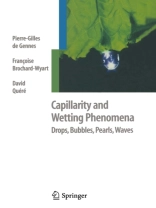As I glance out my window in the early morning, I can see beads of droplets gracing a spider web. The film of dew that has settled on the threads is unstable and breaks up spontaneously into droplets. This phenomenon has implications for the treatment of textile fibers (the process known as "oiling"), glass, and carbon. It is no less important when applying mascara! I take my morning shower. The moment I step out, I dry off by way of evaporation (which makes me feel cold) and by dewetting (the process by which dry areas form spontaneously and expand on my skin). As I rush into my car under a pelting rain, my attention is caught by small drops stuck on my windshield. I also notice larger drops rolling down and others larger still that, like snails, leave behind them a trail of water. I ask myself what the difference is between these rolling drops and grains of sand tumbling down an incline. I wonder why the smallest drops remain stuck. The answers to such questions do help car manufacturers treat the surface of glass and adjust the tilt of windshields.
Francoise Brochard-Wyart & Pierre-Gilles de Gennes
Capillarity and Wetting Phenomena [PDF ebook]
Drops, Bubbles, Pearls, Waves
Capillarity and Wetting Phenomena [PDF ebook]
Drops, Bubbles, Pearls, Waves
Придбайте цю електронну книгу та отримайте ще 1 БЕЗКОШТОВНО!
Мова Англійська ● Формат PDF ● ISBN 9780387216560 ● Видавець Springer New York ● Опубліковано 2013 ● Завантажувані 3 разів ● Валюта EUR ● Посвідчення особи 4623357 ● Захист від копіювання Adobe DRM
Потрібен читач електронних книг, що підтримує DRM












